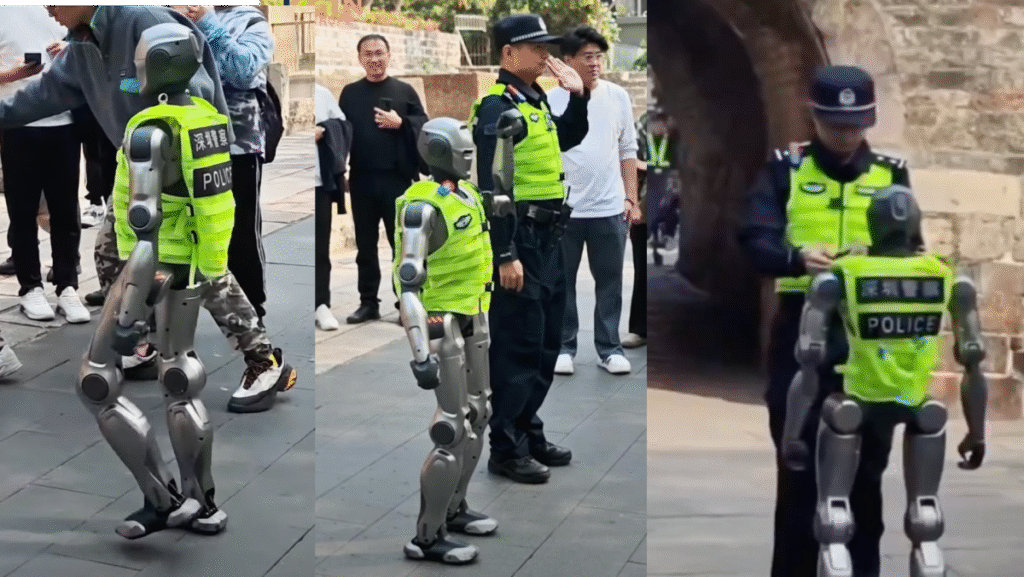In a striking blend of futuristic technology and urban necessity, Shanghai unveiled its very own RoboCop robot this week not from the scenes of a Hollywood blockbuster but at a real world traffic intersection in the heart of the Huangpu District. This humanoid police robot, clad in a reflective uniform with glowing LED accents, stunned onlookers as it gave directions, signaled traffic, and issued voice commands like a seasoned officer.
With the focus on enhancing urban traffic safety and leveraging smart city infrastructure, this moment marked a pivotal shift in how technology is becoming an integral part of public order.
A New Kind of Officer: RoboCop Robot Shanghai Takes the Streets
Standing tall amidst buzzing scooters, honking taxis, and hurried pedestrians, the RoboCop robot Shanghai appearance was more than just a media stunt it was a demonstration of China’s leap toward AI led public management. The robot issued commands such as Red light, please stop with clear audio instructions and gestured with animated, LED lit hands to guide pedestrians across the crosswalk.
Wearing a helmet reminiscent of sci-fi designs and a high visibility outfit, the humanoid robot not only enforced basic traffic protocols but also gathered data acting as both law enforcer and urban analyst.
Shanghai’s Smart City Vision in Action
Shanghai’s government has long pushed for a smart city ecosystem. This traffic directing robot is part of a broader initiative to integrate AI robotics into urban governance. In 2023, Shanghai piloted similar autonomous systems in airport security. However, placing a humanoid robot in open public intersections marks a bold expansion.
This RoboCop robot Shanghai project, reportedly developed in collaboration with a local robotics firm and municipal tech offices, aims to study real time interactions between humans and machines in chaotic city settings.
This Is Just the Beginning
According to Professor Liu Cheng, an AI ethics and robotics expert at Fudan University, This humanoid police robot is a significant step in applying robotics to real world challenges. It’s not just about novelty it’s about safety, consistency, and learning from human behavior patterns.
Professor Liu also emphasized that one of the robot’s key advantages is its non fatigued performance. Unlike human officers, robots can stand for hours, give repeated instructions without frustration, and handle dangerous tasks without personal risk, he added.
Awe, Curiosity, and Skepticism
Locals were understandably intrigued. Ms. Lin, a nearby bakery owner, shared her thoughts. I’ve seen robots in malls, but seeing one in the street, directing people like a real officer it felt like the future arrived suddenly.
However, not all reactions were rosy. A delivery driver, Mr. Zhao, expressed mild concern. What if it malfunctions during rush hour? Or people don’t take it seriously?
Despite mixed reviews, the RoboCop robot Shanghai initiative sparked curiosity and conversation a sign that it succeeded in capturing public interest, at the very least.
Why RoboCop Robots May Be the Future
China’s commitment to AI leadership is well documented. But this real world application is not just about innovation it’s about addressing critical urban problems.
Traffic Accidents: Pedestrian safety remains a top concern in fast paced cities. A robot that strictly enforces crosswalk rules could save lives.
Officer Shortage: With police resources often stretched, robot assistants can handle repetitive or non critical roles, freeing up human officers.
Public Surveillance: These robots also serve as surveillance hubs, capturing footage and data that can help manage incidents and patterns over time.
From Tokyo to Dubai, countries have tested security robots. But what sets the RoboCop robot Shanghai apart is its visible command role in managing public behavior something that was, until now, strictly human led.
What Comes Next From Intersection to Institution?
If feedback and performance data remain positive, the local government may expand this pilot project to more intersections and possibly even metro stations and festivals. Integration with facial recognition and license plate tracking could follow, raising both possibilities and ethical questions.
Professor Liu warns, With power comes responsibility. Deploying these robots needs strict regulation, accountability frameworks, and public transparency.
RoboCop Robot Shanghai Symbol of Progress or a Glimpse of Overreach?
Whether you view it as innovation or intrusion, the debut of a real life RoboCop robot in Shanghai is undeniable proof that the lines between science fiction and civic reality are blurring. As this LED clad enforcer silently commands busy streets, the world watches wondering if this robot is just a clever traffic controller, or the prototype of a future where humanoid machines enforce society’s rules.
Only time will tell if RoboCop becomes a fixture of the future or remains a fascinating experiment in AI urban governance.

